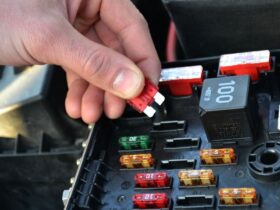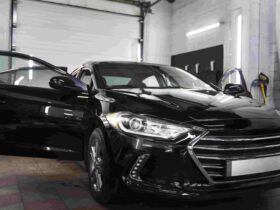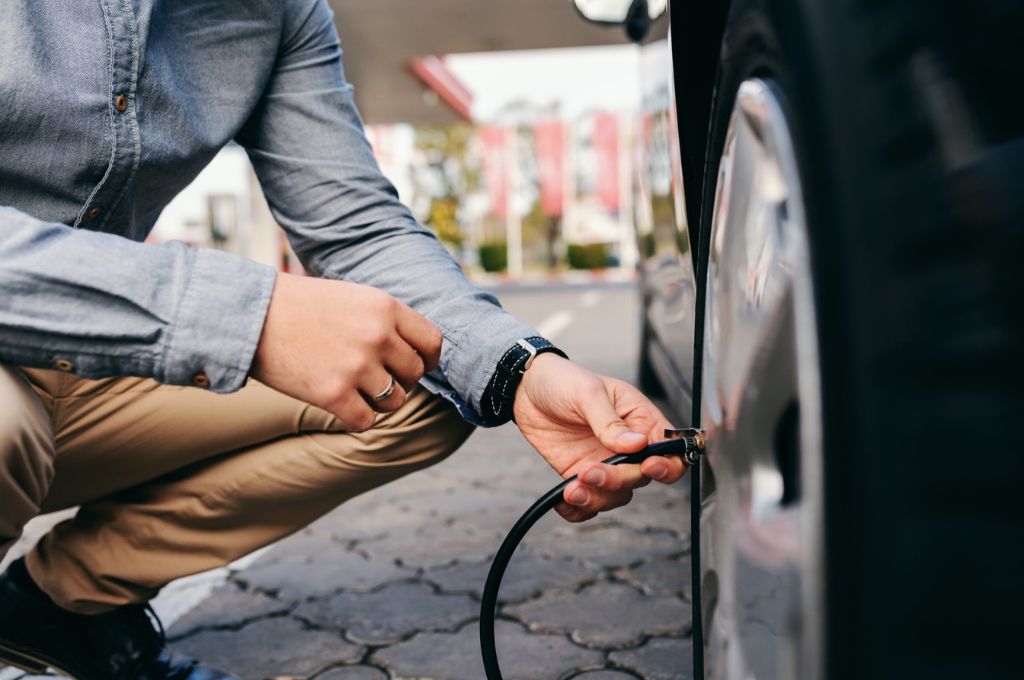Selecting the perfect colour for your vehicle is one of the most significant decisions you’ll make regarding your car’s aesthetics. Blue automotive paint has been a long-standing favourite for vehicle owners worldwide due to its versatility, elegance, and timeless appeal. Blue holds strong psychological significance, adding beauty and a sense of sophistication, trust, and professionalism to any car. Whether you’re restoring a vintage vehicle, customizing a new model, or simply refreshing the look of your ride, blue offers the perfect solution to elevate your car’s aesthetic.
From classic hues to trendy metallic finishes, blue automotive paint comes in various shades and types, each offering a unique visual effect and charm. This comprehensive guide will delve into everything you need to know about blue automotive paint, including the available types, factors to consider when choosing the correct shade, how to apply it effectively, and how to maintain its stunning finish. By the end of this guide, you will have all the knowledge required to make an informed decision, ensuring that your vehicle stands out with a flawless blue paint job.
Table of Contents
- Introduction to Blue Automotive Paint
- The Popularity of Blue Paint in Automotive Design
- Psychological Impact and Associations of Blue in Vehicles
- Types of Blue Automotive Paint
- Classic Blue: Traditional and Timeless
- Metallic Blue: Sparkle and Shine
- Pearl Blue: Iridescent Elegance
- Matte Blue: Modern and Sleek
- Custom Blue: Tailored to Your Vision
- Choosing the Right Blue Paint for Your Vehicle
- Vehicle Type and Style Considerations
- The Influence of Regional Climate and Environment
- Budgeting for Blue Paint Jobs
- Understanding Your Personal Preferences: Bold or Subtle?
- How to Apply Blue Automotive Paint
- Preparing the Surface for Painting
- The Application Process: Achieving a Flawless Finish
- Curing and Drying Times: How Long Does It Take?
- The Importance of Clear Coats for Protection and Shine
- Maintaining Blue Automotive Paint
- Regular Cleaning and Washing Techniques
- Protecting Blue Paint from Environmental Damage
- Repairing Chips, Scratches, and Surface Imperfections
- Essential Tips for Maintaining Your Car’s New Look
- Advantages of Blue Automotive Paint
- Aesthetic Appeal: Blue’s Versatility and Universality
- Durability: How Blue Paint Holds Up Over Time
- The Positive Impact on Resale Value
- The Psychological and Emotional Appeal of Blue
- How Blue Reflects Personality and Identity
- Blue’s Enduring Popularity in the Automotive Industry
- The Influence of Blue in Car Branding and Marketing
- Blue Paint in the Real World
- Iconic Vehicles Painted Blue
- Blue Cars in Popular Culture and Media
- The Use of Blue by Leading Car Brands
- Common Issues with Blue Automotive Paint
- Fading, Oxidation, and Color Shifts Over Time
- Scratches, Chips, and Surface Damage
- Environmental Factors that Affect Blue Paint
- Conclusion: The Timelessness and Versatility of Blue Automotive Paint
1. Introduction to Blue Automotive Paint
The Popularity of Blue Paint in Automotive Design
Blue automotive paint has been a favorite color choice for car owners for decades. It is one of the most versatile and timeless colors, suitable for virtually any type of vehicle. From classic luxury sedans to powerful sports cars and off-road trucks, blue has a universal appeal. The color transcends trends and continues to remain a top choice among vehicle owners around the world.
Throughout history, blue has represented sophistication, trust, and reliability. For many car manufacturers, blue symbolizes innovation and high-performance qualities. As car designs have evolved, so too have the variations of blue available, offering different finishes such as metallic, pearl, matte, and custom blue. With so many choices available, blue continues to dominate the automotive world for its ability to work well with modern and classic designs.
Psychological Impact and Associations of Blue in Vehicles
The color blue evokes psychological associations with calmness, reliability, and professionalism. It is also linked to intelligence, tranquility, and a sense of authority. For car owners, blue can reflect their personality, signalling confidence and reliability.
Car buyers often gravitate towards blue vehicles because of the soothing effect that the color has, making it easier to associate with a calm, controlled driving experience. Additionally, blue stands out on the road without being overpowering, making it an excellent choice for individuals who want their vehicles to be noticed but not excessively bold.
2. Types of Blue Automotive Paint
Classic Blue: Traditional and Timeless
Classic blue is a deep, vibrant shade that exudes sophistication and enduring elegance. It’s the kind of blue that never goes out of style and can be found in vehicles from luxury sedans to classic muscle cars. Classic blue often invokes a sense of stability and professionalism, making it a popular choice for business executives and luxury car owners. It’s versatile enough to work well on older models and modern designs.
Metallic Blue: Sparkle and Shine
Metallic blue is one of the most popular choices in automotive paint due to its eye-catching finish. This paint contains metallic flakes that create a reflective surface, causing the paint to shine and shimmer under direct light. Metallic blue is often used for sports cars, performance vehicles, and luxury models because it highlights the car’s curves and lines, making it look more dynamic and modern. It also provides added depth, making the vehicle appear more high-end.
Pearl Blue: Iridescent Elegance
Pearl blue is an elegant and refined finish, featuring a captivating iridescent effect. It contains microscopic particles that reflect light, causing the color to shift depending on the angle and lighting conditions. This shifting effect makes pearl blue stand out and adds depth and complexity to the vehicle’s appearance. Pearl blue is often used on high-performance sports cars and premium vehicles, giving them an exquisite, one-of-a-kind look.
Matte Blue: Modern and Sleek
Matte blue is a non-reflective finish with a sleek, understated, modern aesthetic. Unlike glossy finishes like metallic and pearl blue, matte blue creates a smooth, velvety appearance that looks fresh and contemporary. It is particularly popular among car enthusiasts who prefer a more subtle, edgy look for their vehicles. Matte blue is commonly seen on performance cars and custom builds. However, it is essential to note that matte finishes require extra care and maintenance to avoid visible scratches and imperfections.
Custom Blue: Tailored to Your Vision
Custom blue is ideal for those who want a unique color for their vehicle. It offers endless possibilities—you can mix different shades of blue or incorporate special finishes like matte, metallic, or pearlescent effects. Custom blue allows car owners to create a one-of-a-kind vehicle that reflects their style. Whether you want a bright neon blue or a darker, subdued shade, custom blue will enable you to design a color that fits your vision perfectly.
3. Choosing the Right Blue Paint for Your Vehicle
Vehicle Type and Style Considerations
The first step in choosing blue automotive paint is to consider the type and style of your vehicle. Different types of cars lend themselves better to varying shades of blue. For example:
- Sports Cars: Bright blue shades like cobalt or electric blue often work well on sports cars, as they emphasize the car’s dynamic, high-performance character.
- Luxury Sedans: Darker shades like navy or midnight blue are perfect for luxury sedans, providing a sophisticated and classy appearance.
- SUVs and Trucks: For larger vehicles like trucks and SUVs, deeper and more subdued blues like steel or dark blue are ideal, as they convey strength and durability.
The Influence of Regional Climate and Environment
Climate significantly affects how your blue paint will hold up over time. For example, metallic and pearl blue finishes are more resistant to fading from the sun’s UV rays, making them suitable for hot climates where sun exposure is frequent. Matte finishes, on the other hand, are more prone to fading and may require extra protection from the sun if you live in a sunny area.
If you live in an area with frequent rain or humidity, opt for a more durable paint option that can withstand these elements without easily fading or oxidizing. Metallic and pearl finishes are typically more environmentally resistant than matte finishes.
Budgeting for Blue Paint Jobs
Blue automotive paint has various price points depending on the type and quality. Classic blue is often the most affordable option, while custom and specialty finishes like metallic and pearl blues can be more expensive. It is essential to budget for not only the cost of the paint but also additional expenses such as primer, clear coats, labor, and any touch-up work that may be required.
4. How to Apply Blue Automotive Paint
Preparing the Surface for Painting
Preparing the vehicle’s surface is the first step in applying blue paint. Begin by washing the car thoroughly to remove dirt and grime. Use a car-specific detergent to ensure you do not leave any residue behind. Once the vehicle is clean, use fine-grit sandpaper to lightly sand the surface, removing imperfections. This step ensures optimal paint adhesion, resulting in a flawless and uniform finish.
The Application Process: Achieving a Flawless Finish
Once the surface is prepared, it’s time to begin applying the paint. When using blue automotive paint, working in thin, even layers is crucial. Apply the paint in light coats, allowing each layer to dry before applying the next. This process helps avoid drips, streaks, and uneven application. Keep the spray gun or paint can about 6 to 8 inches from the surface for optimal coverage. Always spray in smooth, sweeping motions, ensuring even coverage across the entire surface.
Curing and Drying Times: How Long Does It Take?
Drying and curing times vary depending on the type of paint and environmental conditions. Generally, allow each coat to dry for at least 30 minutes to an hour before applying the next. Once all coats are applied, the paint will cure for several hours or days to ensure it fully hardens and bonds to the vehicle’s surface.
The Importance of Clear Coats for Protection and Shine
Once the blue paint has dried and cured, applying a clear coat is essential for added protection. Clear coats provide a glossy finish and help protect the paint from scratches, UV damage, and environmental contaminants. The clear coat serves as a protective barrier, ensuring that your blue paint job remains vibrant and well-maintained for longer.
5. Maintaining Blue Automotive Paint
Regular Cleaning and Washing Techniques
To maintain the beauty of your blue automotive paint, it is essential to clean the vehicle regularly. Wash your car at least once a week to remove dirt, dust, and contaminants that can cause surface damage. Use a shampoo designed for cars to protect the wax or sealant, and always dry the car with a microfiber cloth to prevent scratches.
Protecting Blue Paint from Environmental Damage
Blue paint, particularly metallic and pearl finishes, can be susceptible to UV damage. Apply a high-quality wax or sealant regularly to protect the paint from sun exposure. This will create a protective layer that helps shield the paint from harmful UV rays, pollutants, and other environmental factors.
Repairing Chips, Scratches, and Surface Imperfections
Over time, chips and scratches may occur on the paint’s surface. These flaws can influence the overall appearance of your vehicle. Fortunately, small chips and scratches can be repaired with touch-up paint that matches the color of your car. For more significant damage, you may need to reapply the paint or take the vehicle to a professional for more extensive repairs.
Essential Maintenance Tips to Keep Your Car Looking Like New
Perform regular maintenance to ensure that your blue automotive paint remains vibrant and long-lasting. Wash the car frequently, apply protective coatings like wax or paint sealant, and avoid exposing the vehicle to harsh environmental conditions. By following these tips, you can extend the life of your blue paint and keep your vehicle looking like new for years to come.
6. Advantages of Blue Automotive Paint
Aesthetic Appeal: Blue’s Versatility and Universality
Blue is an incredibly versatile color that works well on all types of vehicles. From the classic elegance of navy to the bright vibrancy of electric blue, blue paint can be customized to suit any vehicle style, whether it’s a luxury sedan, a rugged truck, or a sporty coupe. Blue has universal appeal, making it an excellent choice for personal and professional vehicles.
Durability: How Blue Paint Holds Up Over Time
High-quality blue automotive paint, especially metallic and pearl finishes, is highly durable. These finishes resist fading, oxidation, and environmental damage better than other colors. This durability ensures that your car will remain beautiful for many years, even with regular exposure to sunlight, rain, and pollutants.
The Positive Impact on Resale Value
Blue vehicles tend to have higher resale values than cars in other colors. The demand for blue cars is consistently high, as the color appeals to a broad audience.If you choose to sell your vehicle later on, a well-preserved blue paint finish can increase its attractiveness to potential buyers and raise its resale value.
7. The Psychological and Emotional Appeal of Blue
How Blue Reflects Personality and Identity
The choice of blue paint reflects your personality and identity. People who choose blue for their vehicles often value reliability, professionalism, and sophistication. Blue automotive paint symbolizes trust and tranquility, making it an ideal choice for those who wish to project a confident yet approachable persona.
Blue’s Enduring Popularity in the Automotive Industry
Blue has been a staple in the automotive industry for over a century. Its enduring charm and adaptability make it a popular choice among both car manufacturers and owners. Whether purchasing a new car or restoring a classic, blue remains a color that never goes out of style.
The Influence of Blue in Car Branding and Marketing
Car manufacturers often use blue in their branding and marketing materials to symbolize trust, quality, and dependability. Blue is commonly seen in advertisements for luxury, sports, and high-performance models, reinforcing that these vehicles offer superior quality and design.
8. Blue Paint in the Real World
Iconic Vehicles Painted Blue
Blue has adorned numerous iconic cars throughout the years. Whether it’s the bright blue Ford Mustang or the navy Porsche 911, blue has been a color associated with performance, luxury, and style. These cars demonstrate how blue enhances any vehicle, accentuating curves, contours, and design details.
Blue Cars in Popular Culture and Media
Blue cars frequently appear in movies, TV shows, and advertisements, symbolizing speed, power, and elegance. In pop culture, blue is often used to represent sophistication and modernity. Many car brands incorporate blue into their vehicles to reflect these qualities, making the color a symbol of high performance and luxury.
The Use of Blue by Leading Car Brands
Leading car manufacturers like BMW, Audi, and Ford frequently offer blue options on their high-end and sports car models. Blue paint elevates the vehicle’s aesthetic appeal while reinforcing its identity as a high-performance, luxury product.
9. Common Issues with Blue Automotive Paint
Fading, Oxidation, and Color Shifts Over Time
Like all paint finishes, blue paint can fade over time, especially when exposed to the sun for extended periods. To prevent fading, apply protective wax or sealant regularly. Additionally, some blue paints, especially matte finishes, are more prone to oxidation and color shifts. Consistent maintenance is crucial to maintaining the paint’s vibrant look.
Scratches, Chips, and Surface Damage
Scratches and chips are common problems for vehicles with blue paint, particularly metallic and pearl finishes. While these finishes are more durable than standard paints, they can still be damaged by harsh environmental conditions or accidental impacts. Tackle small damages promptly to prevent them from worsening.
Environmental Factors That Affect Blue Paint
Environmental elements such as bird droppings, tree sap, and road salt can harm the surface of blue automotive paint. Regular cleaning and prompt removal of contaminants are essential to prevent long-term damage. Using a protective coating or paint sealant will also help reduce the impact of environmental factors.
10. Conclusion: The Timelessness and Versatility of Blue Automotive Paint
Blue automotive paint continues to be a timeless, sophisticated, and versatile choice for car owners. From its aesthetic appeal to its long-lasting durability, blue offers many options to suit any car owner’s needs. Whether you favor the timeless elegance of navy or the contemporary allure of metallic blue, the color always adds a touch of luxury and style to any vehicle.
By choosing blue automotive paint, you are investing in a color that will enhance your vehicle’s appearance and maintain its beauty for years. With proper care, your blue paint job will remain vibrant, giving your car a fresh, polished look that turns heads on the road.






Leave a Reply